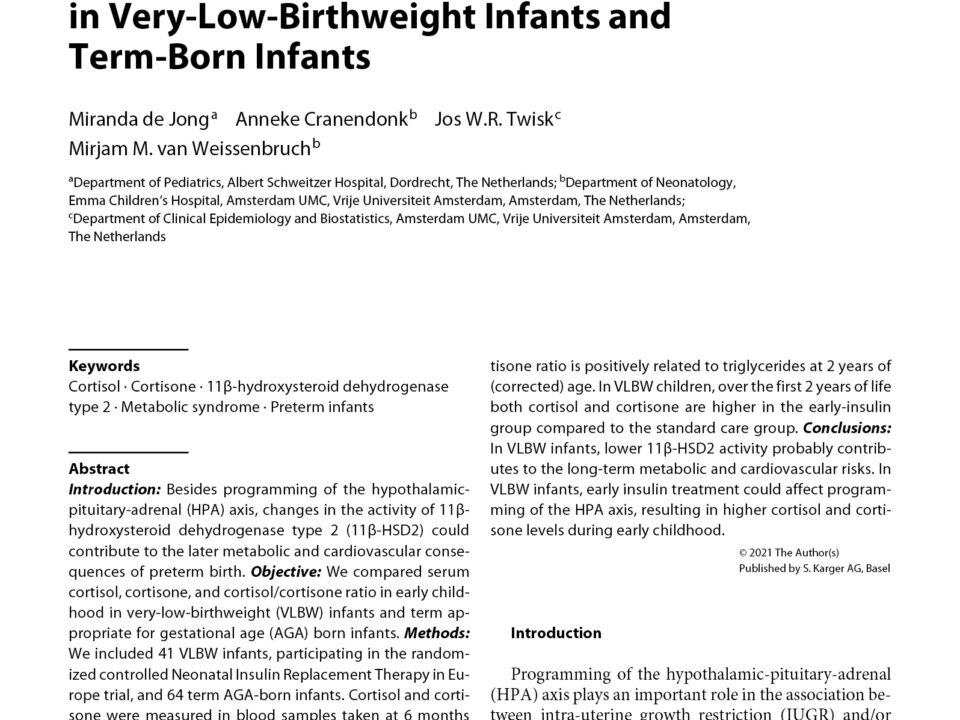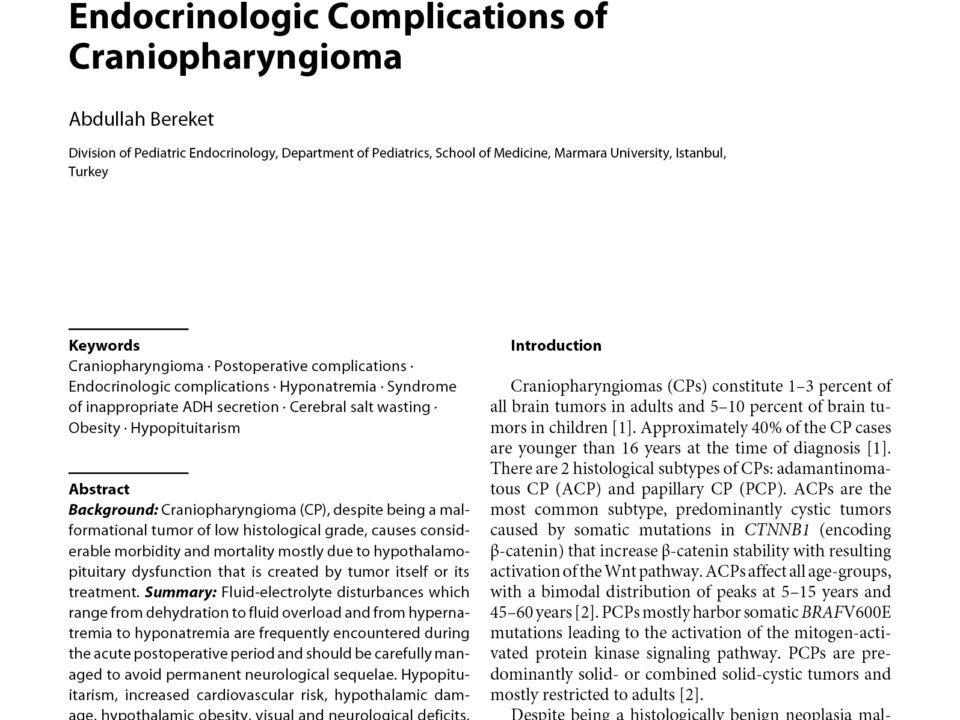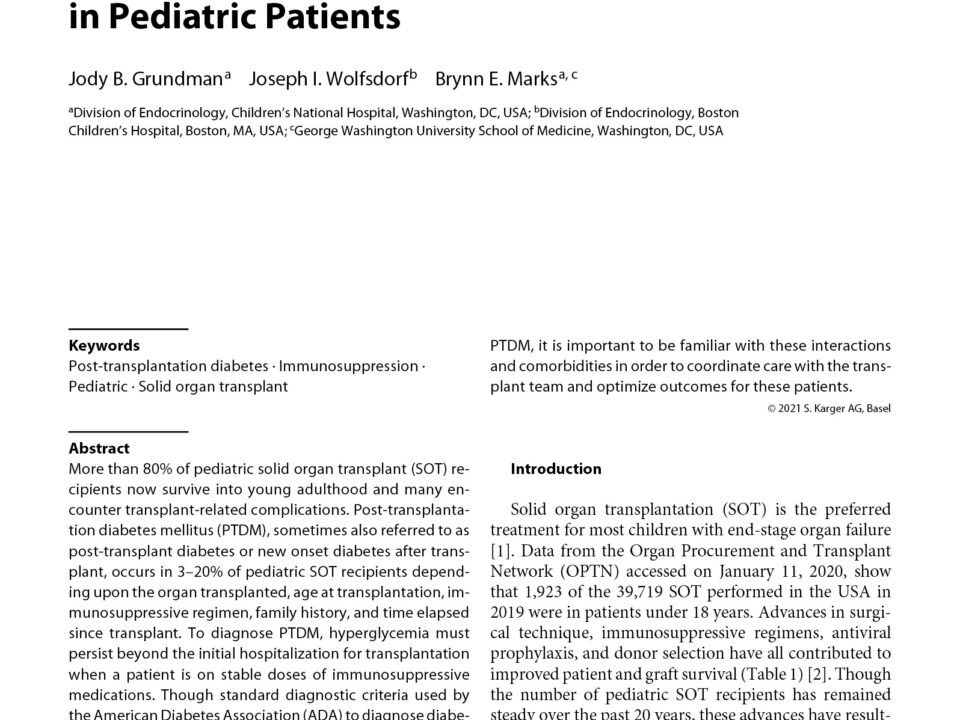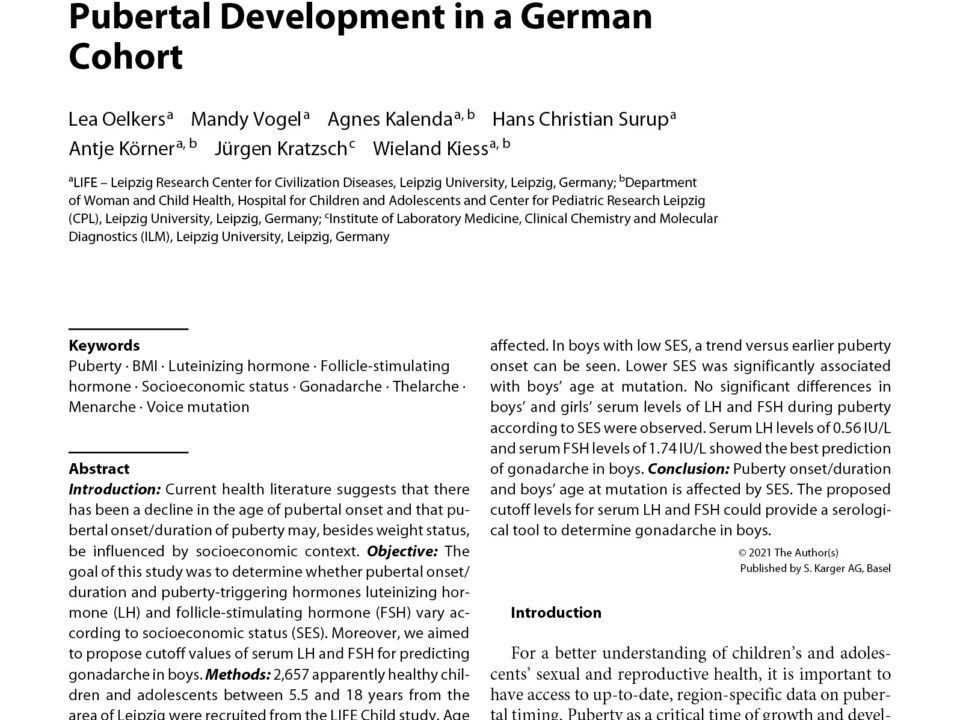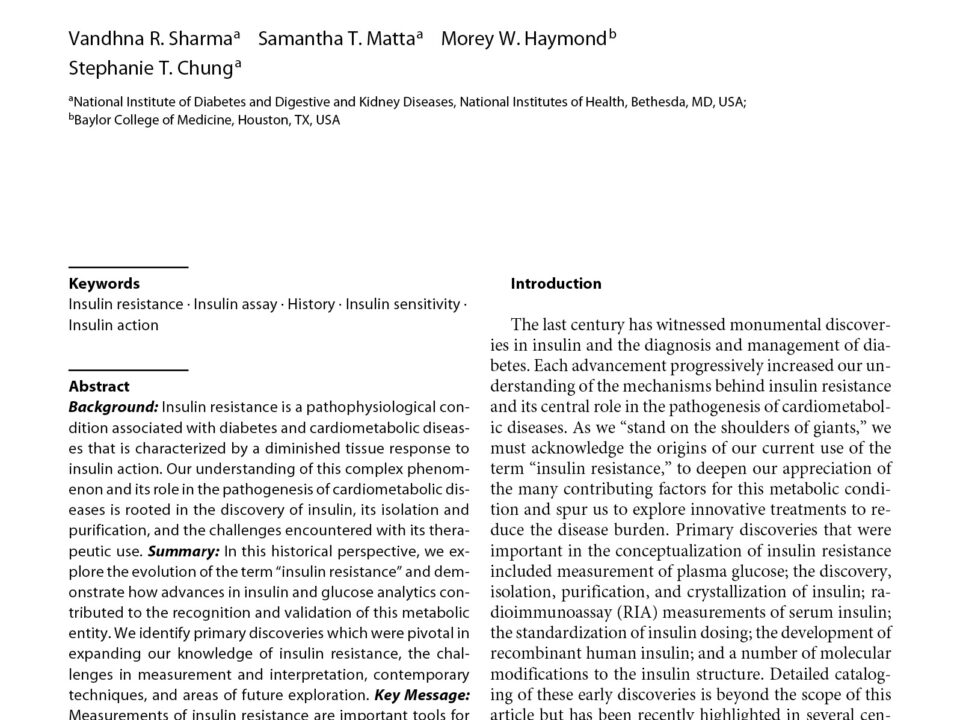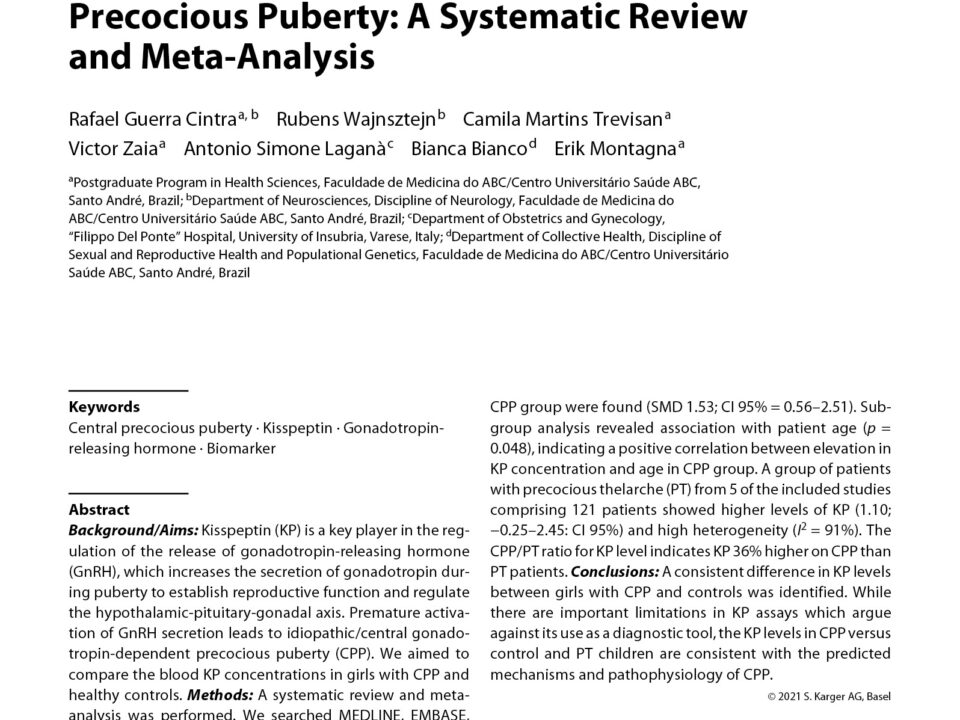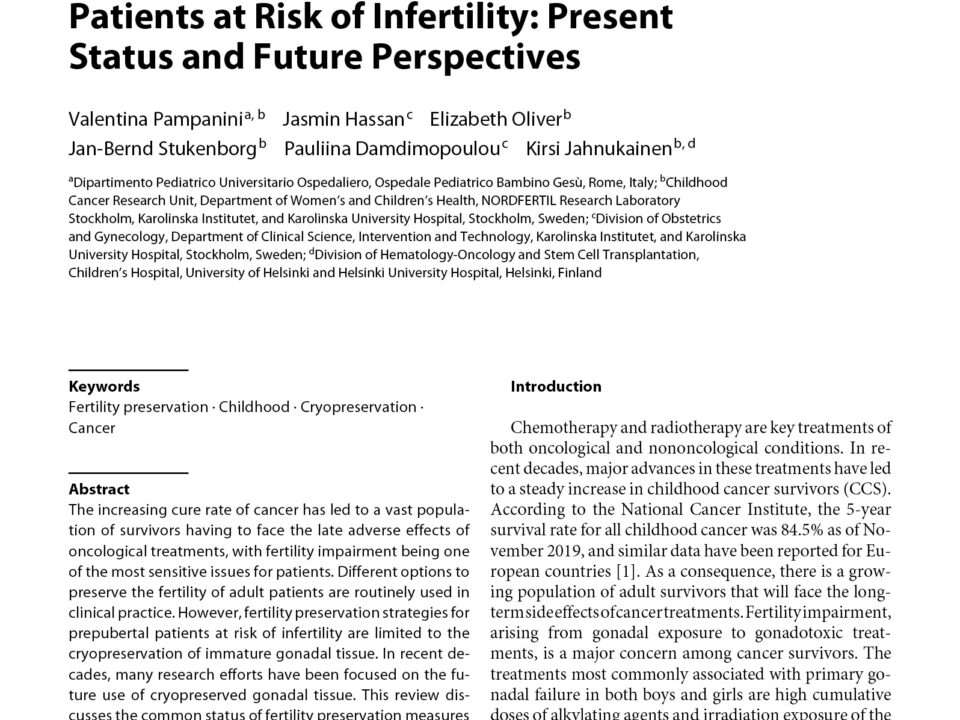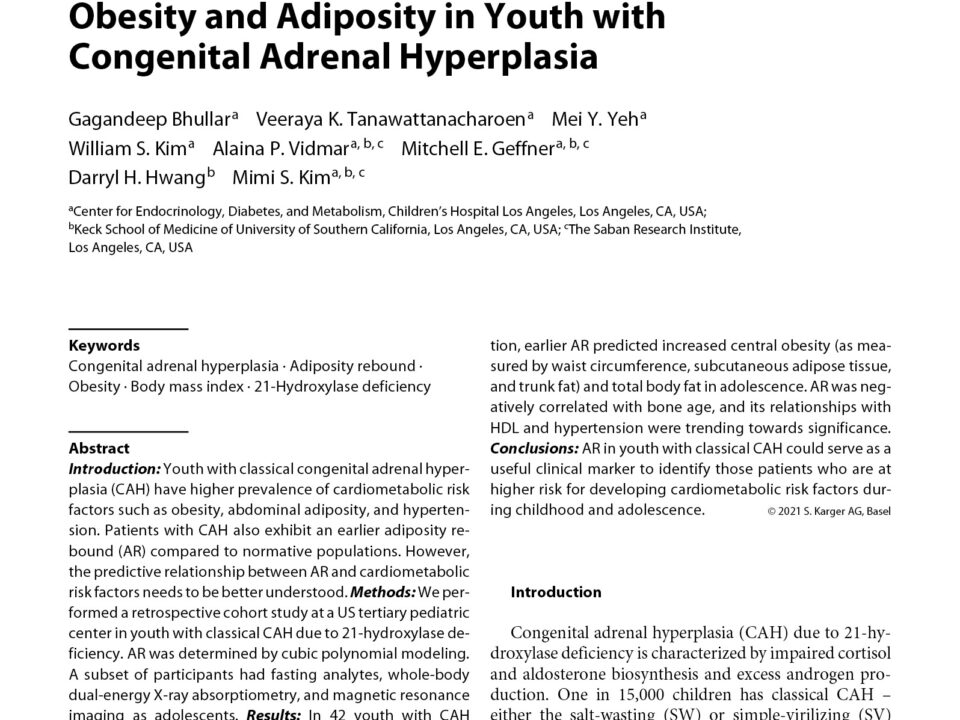December 13, 2022
Introduction: Besides programming of the hypothalamic-pituitary-adrenal (HPA) axis, changes in the activity of 11β-hydroxysteroid dehydrogenase type 2 (11β-HSD2) could contribute to the later metabolic and cardiovascular consequences of preterm birth. Objective: We compared serum cortisol, cortisone, and cortisol/cortisone ratio in early childhood in very-low-birthweight (VLBW) infants and term appropriate for gestational age (AGA) born infants. Methods: We included 41 VLBW infants, participating in the randomized controlled Neonatal Insulin Replacement Therapy in Europe trial, and 64 term AGA-born infants. Cortisol and cortisone were measured in blood samples taken at 6 months and 2 years corrected age (VLBW children) and at 3 months and 1 and 2 years (term children). At 2 years of (corrected) age (HDL) cholesterol, triglycerides, glucose, and insulin were also measured. Results: During the first 2 years of life, cortisol/cortisone ratio is higher in VLBW children compared to term children. In the total group of children, cortisol/cortisone ratio is positively related to triglycerides at 2 years of (corrected) age. In VLBW children, over the first 2 years of life both cortisol and cortisone are higher in the early-insulin group compared to the standard care group. Conclusions: In VLBW infants, lower 11β-HSD2 activity probably contributes to the long-term metabolic and cardiovascular risks. In VLBW infants, early insulin treatment could affect programming of the HPA axis, resulting in higher cortisol and cortisone levels during early childhood.
December 13, 2022
Background: Craniopharyngioma (CP), despite being a malformational tumor of low histological grade, causes considerable morbidity and mortality mostly due to hypothalamo-pituitary dysfunction that is created by tumor itself or its treatment. Summary: Fluid-electrolyte disturbances which range from dehydration to fluid overload and from hypernatremia to hyponatremia are frequently encountered during the acute postoperative period and should be carefully managed to avoid permanent neurological sequelae. Hypopituitarism, increased cardiovascular risk, hypothalamic damage, hypothalamic obesity, visual and neurological deficits, and impaired bone health and cognitive function are the morbidities affecting the well-being of these patients in the long term. Key Messages: Timely and optimal treatment of early postoperative and long-term complications of CP is crucial for preserving quality of life of these patients.
December 13, 2022
More than 80% of pediatric solid organ transplant (SOT) recipients now survive into young adulthood and many encounter transplant-related complications. Post-transplantation diabetes mellitus (PTDM), sometimes also referred to as post-transplant diabetes or new onset diabetes after transplant, occurs in 3–20% of pediatric SOT recipients depending upon the organ transplanted, age at transplantation, immunosuppressive regimen, family history, and time elapsed since transplant. To diagnose PTDM, hyperglycemia must persist beyond the initial hospitalization for transplantation when a patient is on stable doses of immunosuppressive medications. Though standard diagnostic criteria used by the American Diabetes Association (ADA) to diagnose diabetes are employed, clinicians need to be aware of the limitations of using these criteria in this unique patient population. Management of PTDM parallels strategies used for type 2 diabetes (T2D), while also carefully considering comorbidities and potential interactions with immunosuppressive medications in these patients. In caring for patients with PTDM, it is important to be familiar with these interactions and comorbidities in order to coordinate care with the transplant team and optimize outcomes for these patients.
December 13, 2022
Background: Gonadotropin-releasing hormone analogues (GnRHa) administered as depot formulations are the standard of care for children with central precocious puberty (CPP). Puberty resumes after treatment discontinuation, but little is known concerning fertility in women who have been treated with GnRHa for CPP during childhood. Methods: The PREFER (PREcocious puberty, FERtility) study prospectively analysed fertility, via a series of questionnaires, in women treated during childhood with triptorelin (depot formulation) for CPP. Co-primary endpoints were the proportion of women wanting a pregnancy any time before study inclusion and during the follow-up period but not pregnant 6 and 12 months after stopping contraception and the waiting time to pregnancy (WTP). Results: A total of 574 women were identified, and 194 women were included in the analysis. Although there were not enough data for primary endpoint assessment, few women (1.7%) reported issues with fertility or were unable to become pregnant despite trying to conceive. Most pregnancies (84.4%, 95% CI [67.2–94.7%]) occurred within 1 year of trying to conceive, in line with the WTP for women without previous CPP. Conclusion: The results, based on a limited sample of patients, suggest that CPP treated with triptorelin does not negatively impact women’s fertility in adulthood. These results need to be consolidated with a subsequent study performed when these women will have reached their mid-thirties.
December 13, 2022
Introduction: Current health literature suggests that there has been a decline in the age of pubertal onset and that pubertal onset/duration of puberty may, besides weight status, be influenced by socioeconomic context. Objective: The goal of this study was to determine whether pubertal onset/duration and puberty-triggering hormones luteinizing hormone (LH) and follicle-stimulating hormone (FSH) vary according to socioeconomic status (SES). Moreover, we aimed to propose cutoff values of serum LH and FSH for predicting gonadarche in boys. Methods: 2,657 apparently healthy children and adolescents between 5.5 and 18 years from the area of Leipzig were recruited from the LIFE Child study. Age at pubertal onset/end of puberty was given in 738/573 children, respectively. Anthropometric parameters of puberty, blood measurements of LH and FSH, and questionnaires assessing SES were evaluated. Results: Lower SES was associated with earlier thelarche and longer duration of puberty in overweight/obese girls, whereas age of menarche was not affected. In boys with low SES, a trend versus earlier puberty onset can be seen. Lower SES was significantly associated with boys’ age at mutation. No significant differences in boys’ and girls’ serum levels of LH and FSH during puberty according to SES were observed. Serum LH levels of 0.56 IU/L and serum FSH levels of 1.74 IU/L showed the best prediction of gonadarche in boys. Conclusion: Puberty onset/duration and boys’ age at mutation is affected by SES. The proposed cutoff levels for serum LH and FSH could provide a serological tool to determine gonadarche in boys.
December 13, 2022
Background: Insulin resistance is a pathophysiological condition associated with diabetes and cardiometabolic diseases that is characterized by a diminished tissue response to insulin action. Our understanding of this complex phenomenon and its role in the pathogenesis of cardiometabolic diseases is rooted in the discovery of insulin, its isolation and purification, and the challenges encountered with its therapeutic use. Summary: In this historical perspective, we explore the evolution of the term “insulin resistance” and demonstrate how advances in insulin and glucose analytics contributed to the recognition and validation of this metabolic entity. We identify primary discoveries which were pivotal in expanding our knowledge of insulin resistance, the challenges in measurement and interpretation, contemporary techniques, and areas of future exploration. Key Message: Measurements of insulin resistance are important tools for defining and treating cardiometabolic diseases. Accurate quantification of this pathophysiological entity requires careful consideration of the assumptions and pitfalls of the methodological techniques and the historical and clinical context when interpreting and applying the results.
December 13, 2022
background/Aims: Kisspeptin (KP) is a key player in the regulation of the release of gonadotropin-releasing hormone (GnRH), which increases the secretion of gonadotropin during puberty to establish reproductive function and regulate the hypothalamic-pituitary-gonadal axis. Premature activation of GnRH secretion leads to idiopathic/central gonadotropin-dependent precocious puberty (CPP). We aimed to compare the blood KP concentrations in girls with CPP and healthy controls. Methods: A systematic review and meta-analysis was performed. We searched MEDLINE, EMBASE, The Cochrane Library, and SciELO. Random-effects model and standardized mean difference (SMD) were used. Heterogeneity was assessed through I2. Meta-regression considered patient age, KP fraction, and analytical method for KP measurement. Results: The 11 studies included comprised 316 CPP patients and 251 controls. Higher KP levels in the CPP group were found (SMD 1.53; CI 95% = 0.56–2.51). Subgroup analysis revealed association with patient age (p = 0.048), indicating a positive correlation between elevation in KP concentration and age in CPP group. A group of patients with precocious thelarche (PT) from 5 of the included studies comprising 121 patients showed higher levels of KP (1.10; −0.25–2.45: CI 95%) and high heterogeneity (I2 = 91%). The CPP/PT ratio for KP level indicates KP 36% higher on CPP than PT patients. Conclusions: A consistent difference in KP levels between girls with CPP and controls was identified. While there are important limitations in KP assays which argue against its use as a diagnostic tool, the KP levels in CPP versus control and PT children are consistent with the predicted mechanisms and pathophysiology of CPP.
December 13, 2022
The increasing cure rate of cancer has led to a vast population of survivors having to face the late adverse effects of oncological treatments, with fertility impairment being one of the most sensitive issues for patients. Different options to preserve the fertility of adult patients are routinely used in clinical practice. However, fertility preservation strategies for prepubertal patients at risk of infertility are limited to the cryopreservation of immature gonadal tissue. In recent decades, many research efforts have been focused on the future use of cryopreserved gonadal tissue. This review discusses the common status of fertility preservation measures for pediatric patients undergoing gonadotoxic treatment, focusing especially on the challenges that remain to be solved in order to implement this fundamental service.
December 13, 2022
Introduction: Youth with classical congenital adrenal hyperplasia (CAH) have higher prevalence of cardiometabolic risk factors such as obesity, abdominal adiposity, and hypertension. Patients with CAH also exhibit an earlier adiposity rebound (AR) compared to normative populations. However, the predictive relationship between AR and cardiometabolic risk factors needs to be better understood. Methods: We performed a retrospective cohort study at a US tertiary pediatric center in youth with classical CAH due to 21-hydroxylase deficiency. AR was determined by cubic polynomial modeling. A subset of participants had fasting analytes, whole-body dual-energy X-ray absorptiometry, and magnetic resonance imaging as adolescents. Results: In 42 youth with CAH (45.2% female, 54.8% Hispanic, and 90.5% salt-wasting form), the average age at AR was 3.4 ± 1.3 years. AR differed by BMI-z, with youth with obesity having an earlier AR (2.8 ± 1.0 years) compared to lean youth (4.1 ± 1.3 years, p = 0.001). However, AR did not differ by either CAH form or sex. Earlier AR predicted higher BMI-z at 7 and 12 years of age. In addition, earlier AR predicted increased central obesity (as measured by waist circumference, subcutaneous adipose tissue, and trunk fat) and total body fat in adolescence. AR was negatively correlated with bone age, and its relationships with HDL and hypertension were trending towards significance. Conclusions: AR in youth with classical CAH could serve as a useful clinical marker to identify those patients who are at higher risk for developing cardiometabolic risk factors during childhood and adolescence.
